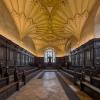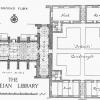II.4 'Privilegium scholasticum': the jurisdiction of the Chancellor's Court
External links
Commentary
A self-governing community. To say that the medieval university was 'self-governing' does not merely mean that that it governed the academic life of university: it exercise independent legal jurisdiction over the entire academic community as well. Once again, this independent legal jurisdiction is nowhere better represented than in the Chancellor's Court which immediately abuts Convocation House in the Bodleian LIbrary complex in Oxford.
Privilegium scholasticum: the medieval backstory. From the mid-twelfth century onward, scholars from across Europe began travelling to Bologna to study civil and canon law. During their travels, and as foreigners in the Italian city, they lacked legal protection. In particular, they were vulnerable to the ‘right of reprisal’, in which their property could be confiscated to settle debts incurred, not only by themselves, but by their countrymen.
If university learning was to spread, scholars studying in foreign lands needed legal protection. In order to encourage the spread of higher learning, the Holy Roman Emperor, Frederick I Barbarossa (1122–1190), issued a document known as the Authentica habita or Privilegium scholasticum, which established in law the rights and privileges of universities and the people studying at them.
Fundamentally, this document extended to scholars rights and protections similar to those already enjoyed by the clergy. Like secular and monastic clergy, matriculated members of the university corporation would be immune from civil jurisdiction: instead, they would be tried by in the bishop’s court or by their own masters in university courts, provided that they distinguished themselves by wearing a variant of clerical dress (hence the title of the document: Authentica habita). As well as immunity from the right of reprisal, they also gained freedom to travel for the purposes of study and teaching. Confirmed by Pope Alexander III and incorporated by the emperor into the Justinian law code, the Authentica habita provided a legal foundation upon which the subsequent history of medieval and early modern universities rests.
Long after the Reformation deprived the clergy of their status as a separate estate under the jurisdiction of ecclesiastical rather than secular courts, members of the university communities in Oxford and Cambridge continued to enjoy this status as a separate community under its own jurisdiction, immune from prosecution in civil courts.
Image: Chancellor's Court, Oxford (1637). Nowhere is the separate legal jurisdiction of the medieval university better reflected today than in the Chancellor's Court (1637) which immediately abutts Convocation House in Bodleian Library-Schoos Quadrangle complex in Oxford. The year before the building was opened, the newly recodified Laudian Statutes of the University of 1636 described the jurisdiction of the university court as follows.
TITLE XXI. Of the Courts of Justice.
CHAPTER 1. Of Preserving the Jurisdiction of the University.
Whereas, not only in conformity with the privileges granted and indulged by the most serene monarchs of this renowned realm ... the power of entertaining and determining all causes which in anywise concern scholars and other privileged [i.e. matriculated] persons (saving cases of freehold, felony, and treason) regards and belongs to the jurisdiction of the Chancellor of the University, it is enacted, that no scholar or privileged person shall, in respect of any cause terminable within the University, convent any person in any court foreign to the University (except in observance of the order of appeal), nor submit himself of free-will to the jurisdiction of any other court, but shall, when impeached elsewhere, make known as early as possible to the Chancellor or Vice-Chancellor the suit wherewith he is threatened; and, in all possible ways be scrupulously careful to preserve the University privileges in this behalf, under penalty, if the party offending be a scholar or privileged person, of being imprisoned and fined as a disturber of the peace; and if he persists in his contumacy, of being ousted of the University privileges. But every person who is not privileged and yet a townsman, and who has, in the cases above mentioned, threatened a scholar or privileged person with a suit, is to be restrained by being forbidden to deal with scholars and privileged persons till he makes satisfaction; but a stranger is to be imprisoned, if he can be caught, for a contempt of the University jurisdiction. The Chancellor also, and the Vice-Chancellor, and all others, are to understand that they respectively are tied and bound in virtue of their oath made to the University, to see, according to their authority and power, that the privileges of the University suffer no violence in this behalf.
CHAPTER 2. Of the Court of the Commissary or Vice-Chancellor of the University.
... once every week during term-time (and the vacations too) ... and in the afternoon of Fridays, a court shall be holden ... in the north chapel of the Church of St. Mary the Virgin,* or in some other place to be assigned by the Vice-Chancellor. The Commissary or Vice-Chancellor of the University, or his deputy, is to preside, ....
In this court the Vice-Chancellor and his deputy shall proceed according to the rights, privileges, and customs of the University, and shall determine on matters conducing to the ordering of the causes and bringing them to a close....
* The statutes were published in 1636, the year before the purpose-built Chancellor's Court was opened underneath Selden End.
Source: Oxford University Statutes, translated by G. R. M. Ward, Volume 1: Containing the Caroline Code, or Laudian Statues, promulgated A.D. 1636 (London, 1845), pp. 217-18.
Further reading. Pearl Kibre, Scholarly Privileges in the Middle Ages: The Rights, Privileges, and Immunities, of Scholars and Universities at Bologna, Padua, Paris, and Oxford (London, 1962), pp. 1-17; Paolo Nardi, 'Relations with Authority', in Hilde de Ridder-Symoens (ed.), Universities in the Middle Ages [= A History of the University in Europe, vol. I] (Cambridge, 1992), here pp. 77-81; Martin Butlin and Evelyn Joll, The Paintings of J.M.W. Turner, revised edn, 2 (New Haven and London, 1984), p. 102.
Further resources. A 3D panorama of the Chancellor's Court can be accessed here (via the Divinity School and Convocation House).
Commentary. Howard Hotson (December 2018)


